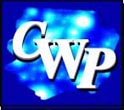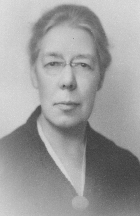 Welcome
to CWP at UCLA
Welcome
to CWP at UCLA  Welcome
to CWP at UCLA Welcome
to CWP at UCLA |
|
86 Eminent Physicists |
Education and the Profession |
|
Contributions Publications Honors |
 Elizabeth Rebecca Laird1874-1969 |
Education Additional Information |
Significant Contributions:From 1901 to 1940, following Marcia Keith as Professor and Head of the Mount Holyoke physics department, Laird trained many women who became active physicists and set an example for the participation of women in research. Research in spectroscopy, thermal conductivity, spark radiation, soft x-rays, the Raman effect, and the electrical properties of biological materials in the microwave region. Some representative publications:
"Absorption in the Region of Soft X-Rays," Physical Review 29: 41 (1927). "Reflection of Soft X-rays," Physical Review 33: 291 (1929). "The Raman Spectrum of Sodium Nitrate, Sodium Acetate, and Acetic Acid," Physical Review 45: 738 (1934), with Dorothy A. Franklin. "Soft X-rays Produced by Cathode Rays of from 200 to 600 Volt Velocities," Phys. Rev. 15:297 (1920). "The Raman Effect in Solutions of Magnesium Sulphate of Varying Concentrations," Physical Review 47: 889 (1935), with Edith M. Coon. In World War II, Laird came out of retirement to work at the University of Western Ontario on the development of radar. She made substantial contributions and was invited to remain at the University.
After WWII, investigated the effects of microwave
radiation on biological materials. [1990 AJP] Jobs/Positions1896-97 Instructor in Mathematics, Whitby Ladies College, Ontario1900-01 Substitute demonstrator in physics, Bryn Mawr College 1901-02 Assistant in Physics, Mt. Holyoke College 1902-03 Instructor in Physics, Mt. Holyoke College 1903-04 Acting Head, Physics Department, Mt. Holyoke College 1904-40 Professor and Head, Physics Department, Mt. Holyoke College 1940-69 Emeritus Professor, Mt. Holyoke College 1941-45 Researcher, Radar Development, Western Ontario University 1945-53 Honorary Professor, Western Ontario University Education
B.A. University of Toronto 1896
Laird also studied at the Cavendish Laboratory, Cambridge University (Summer 1905 and Spring 1909) and the University of Chicago (Fall 1919) Sources and References consulted:Laird Oral History in the AIP Niels Bohr Library and
[osa1969], [6B AMS], [7 MWR1], [17 MWR2], [29 WWWS], [1990 AJP].
The following are extracted from Laird's autobiography in the Oral History section of the AIP Niels Bohr Library.
While studying at the University of Berlin, Laird became the first person to use a Nernst lamp in a physics project. While visiting Berlin in the summer of 1926, Elizabeth Laird heard Otto Hahn speak about his work. She recalled that she "was interested to hear Hahn give the credit for the physics side of the work to Lise Meitner ..." Although women were "not regularly admitted" to Berlin University at the time of her fellowship, Laird recalled that "there wa no crowding in mathematics and physics, and I had no difficulty in getting from the different professors permission to attend their lectures." While studying at the University of Berlin, Laird became the first person to use a Nernst lamp in a physics project.
Extract from a letter Laird wrote her sister while in Berlin:
"Yesterday afternoon I visited Miss Maltby..........There are
Dr. Wendell and his sister, Dr. Wills and Miss Maltby.......
Dr. Wills is from Clark I think, two years ago he and Miss Maltby
were both at the B.A. Association in Toronto and did not know one
another........he is working in Prof. du Bois' private laboratory,
and thinks he has a fine place; he is the only student there
and says he has long talks with the prof. and that he is a fine man
to work with. Miss Maltby is also very much delighted that she
got in with Kohlrausch. Nernst of Gottingen with whom she seem
to be very friendly advised her to work with Warburg, but Dr.
Wendell is so disappointed that she is very glad she didn't.
All three seem to think I should try a theoretical 'Arbeit' with
Planck. I never thought of such a thing when I came, all work
in Physics that I knew of was laboratory work, and I do not know
whether my theory is really sufficiently well forward to attempt
it or not, but if I stay next semester, I almost believe I
shall try. They all think a good American Ph.D. is worth more
than a German one; Dr. Wendell says he doesn't value his at all,
that his diploma from the Boston Technology was worth much more
in his eyes. Of courses he says American graduates come over
here and read a lot and see methods and so improve, but that
the German degree itself means no more than a good B.A. at home;
a rather startling statement, but really the more I see the more
I believe it, except for the fact that one must put in a
thesis of some kind -- and of course one can study a great deal
for it -- but that does not appear in the examination. But then
when he spoke of American work, he spoke of Johns Hopkins & Clark's,
and not of the multitude of inferior places." [Laird's autobiography,
Niels Bohr Library]
History of Science Society American Association of Physics Teachers Canadian Association of Physicists Optical Society of America (member for 47 years) Field EditorsFrieda Stahl/Nina Byers< fstahl@calstatela |
To cite this citation:
" Laird, Elizabeth." CWP
< home >